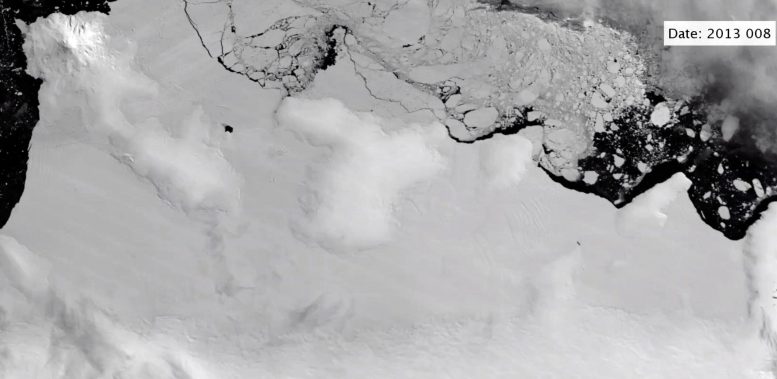
Newly understood factors make ice shelves more vulnerable to breakup according to College of Wooster, University of Colorado at Boulder study.
According to a recent research, the fractured edges of thick, floating Antarctic ice shelves in the Antarctic are being eroded from underneath by upside-down “rivers” of warm ocean water, which is contributing to the circumstances that cause ice shelves to break up and sea levels to increase.
The findings, published on October 9, 2019, in Science Advances, describe a new process important to the future of Antarctica’s ice and the continent’s contribution to rising seas. Models and forecasts do not yet account for the newly understood and troubling scenario, which is already underway.
“Warm water circulation is attacking the undersides of these ice shelves at their most vulnerable points,” said Alley, who earned her Ph.D. at the University of Colorado Boulder, in the National Snow and Ice Data Center, part of CIRES. Alley is now a visiting assistant professor of Earth Sciences at The College of Wooster in Ohio. “These effects matter,” she said. “But exactly how much, we don’t yet know. We need to.”
Ice shelves float out on the ocean at the edges of land-based ice sheets, and about three-quarters of the Antarctic continent is surrounded by these extensions of the ice sheet. The shelves can be hemmed in by canyon-like walls and bumps on the ocean floor. When restrained by these bedrock obstructions, ice shelves slow down the flow of ice from the interior of the continent toward the ocean. But if an ice shelf retreats or falls apart, ice on land flows much more quickly into the ocean, increasing rates of sea-level rise.
The scientists’ new work focuses on two factors conspiring to weaken ice shelves. First, flowing ice often stretches and cracks along its edges or “shear margins,” especially when it’s flowing quickly, Alley said. “In MODIS and other satellite images, you see all these crevasses.”
As those craggy features flow toward the ocean and become part of floating ice shelves, they’re vulnerable to erosion from below, by warm plumes of ocean water, the team reported.
Warm and fresh water is more buoyant than cold and salty water, so it has a tendency to “find” high spots in floating ice, sometimes forming a type of “upside-down river” that can grow miles wide and tens of miles long. Alley and her colleagues first mapped those rivers or “basal channels” a few years ago, spotting them as wrinkles or sags in otherwise smooth ice surfaces.
Now, they’ve put it all together, showing that large basal channels are more likely to form at the shear margins—the weakest parts—of fast-flowing ice shelves. While the ice is still on land, large troughs form in the shear margins, becoming thin spots when the ice flows onto the ocean. Warm ocean water finds those thin spots along the base of the ice shelf, further eroding and weakening margins, making ice shelves more vulnerable to retreat and collapse.
In the past, researchers didn’t know that warm plumes were so common beneath ice-shelf margins. Alley’s team used satellite imagery to show that, at the ends of shear margins on many of Antarctica’s fastest-changing glaciers, warm water rises to the surface, melting sea ice and forming areas of open water called “polynyas.” The study found these polynyas forming year after year in the same spots, which means that warm water is indeed channelizing beneath thin, weak ice-shelf shear margins.
These processes appear to happen on ice shelves in both Antarctica and Greenland, Alley said, though the new work focuses on Antarctic glaciers.
The research team published earlier work focused on the damaging effects of meltwater on the surface of the ice shelves. “Now we’re seeing a new process, where warm water cuts into the shelf from below,” said co-author Ted Scambos, a CIRES senior scientist at CU Boulder. “Like scoring a plate of glass, the trough renders the shelf weak, and in a few decades, it’s gone, freeing the ice sheet to ride out faster into the ocean.”
Scambos and Alley are heading back to Antarctica this fall, to continue work on the continent’s ice dynamics; Scambos is a lead scientist in the International Thwaites Glacier Collaborative.
Reference: “Troughs developed in ice-stream shear margins precondition ice shelves for ocean-driven breakup” by Karen E. Alley, Ted A. Scambos, Richard B. Alley and Nicholas Holschuh, 9 October 2019, Science Advances.
DOI: 10.1126/sciadv.aax2215
Video: Karen Alley/Wooster and NASA MODIS/MODIS Antarctic Ice Shelf Image Archive/NSIDC.
2 Comments
Nice volcanic cone in the upper-left corner of the video. Many are active now. So much we don’t know yet. Why is are children not learning?
Just Thwaite for It. With a Human population of 8 Billion Human Children, It’s bound to heat up. And more people are Reproducing every day.